| |
Trooper Art at Daley Barracks
There was a long tradition of trooper decorative art at
Daley Barracks extending from the earliest days of the U.S.
Army in Bad Kissingen. Great murals were done by unknown
artists of the HQ 64th Fighter Wing, the 14th ACR and the
Eaglehorse. Beyond the red and white traditional colors of
the cavalry, the pure red of HOW Battery or green and yellow
of H Company, soldiers found unique ways to express their
lives and unit pride through barracks art.
| |
Trooper Art
A Sample Collection
[Click on the icon below to
start the tour]
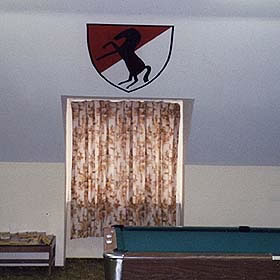 |
|
| |
|
In the early days, a tank could carry an artistic motif and
the squadron always seemed to find a skilled trooper for the
S3 shop to add visual impact to briefings through graphic
art and calligraphy for presentations and certificates. Not
surprisingly, in Day Rooms and Orderly Rooms, a talented
soldier and a First Sergeant could reach agreement to dress
up a bare wall. During the American experience at Daley
Barracks, inspiration, talent and opportunity occasionally
intersected with some spectacular results.
As the site preparation to raze Daley began but before the
buildings came down, the Saale Zeitung sent a photographer
and reporter to record the wall art left behind by the
Americans. A full page article was printed with the title:
'Naive Kitsch or Actual Art?' with large photos of three
murals. The article speculated whether the art was worth
saving and one expert stated the paintings were a great
example of the " spirit of the times " as the soldiers
viewed life. It was impractical to save the actual art work
but the photographic record remains. Although the article
did not give the specific building locations of the murals,
they appear to have been projects of both the 2/11 ACR and 2
- 41 FA. If anyone recognizes the art work and can provide
details, we would appreciate the help.
The donated images capture many great examples of trooper
art at Daley. We are, however, missing one well remembered
mural completely and a complete view of probably the most
famous example of cavalry artwork. In the S2 shop, dating
from 1966, was a large mural showing the combat map of the
14th ACR through Europe during WWII. Primarily hidden behind
a large wall map, Sam Carlson reports that it escaped being
painted over during one AGI prep as he intervened in behalf
of cavalry history. I think it still existed through 81. We
have no image of this work. Found, however are some partial
views of the conference room mural showing the U.S. cavalry
in the southwest, circa 1870.
| |
 |
|
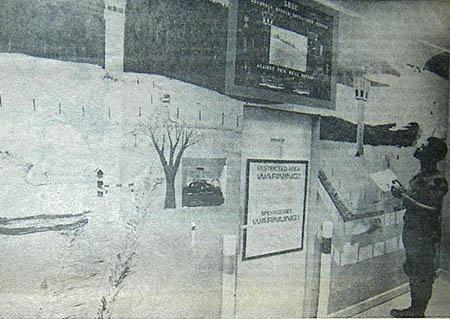 |
|
| |
In the
foreground, local German officials review maps and plans for a
maneuver to insure that ' off limits areas ' are noted. To the rear,
a nice view of the 'March of Armor' trooper art mural in the
Conference Room.
--Rick Badal |
|
SSG
Delbert Richardson puts the finishing touches on his border mural in
this SSG Ric Badal image that appeared in the Sept 1978 edition of
the Blackhorse Newspaper. The security door leads to the SBOC, to
Delbert's right - rear is the door to the S2 shop, the photo is
taken from where, at least as of 1978, the Squadron Staff Duty
Officer had his desk. |
|
Col (Ret) Paul Palmer recalls when it was done, shortly
after he took command in 1966. The trooper artist skillfully
integrated several nude female forms into the landscape that
the cavalry patrolled. The Colonel swears he " approved only
the concept of the artwork " but couldn't bring himself to
have the soldier change the painting once it was done.
CSM (Ret) Ernest C. Jeffries picks up the story:
I was in on that art thing from the beginning, 1966 or so. I
was the squadron CSM and we had one trooper, a draftee I
recall, and there were two things notable about him. He had
no talent for soldiering and was a very good artist! This
young man booted around a couple of the recon Troops and
then I ended up with him, sort of one last chance before we
put him on the train out of town. We were looking to dress
up some of the squadron areas and I had seen the kid's
sketch book so ... what the hell. One of the interesting
things was that much of the work was done with an air brush
and that provided a lot of entertainment by itself. He did
the March of Armor mural, the US cavalry in the West mural
and some scenes in the mess hall. I didn't notice the nudes
until the work was well along but, like Col (Ret) Palmer
said, we didn't have the heart to paint it over. The kid put
a lot of work into the project and it really looked great
when it was done. Can't recall his name, don't remember if
he was a scout or a tanker or what ... do remember he was a
soldier with a special talent and that was enough for me
back in that time and place. When he finally got on the
train out of BK, it was at the end of his regular tour.
| |
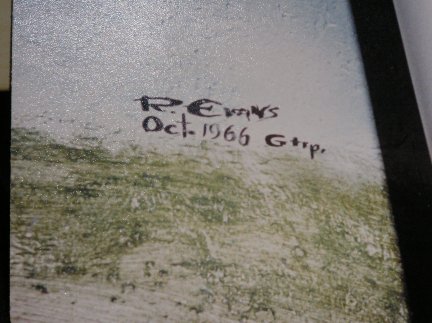 |
|
 |
|
| |
After all
these years, we finally learn the name of the mural artist - R Evans
Troop G 1966. Does anyone recall him?
- Deb Cawley |
|
Two views
of the mural at the end of the Conference Room. The connecting door
to the SCO’s office that was added in the early 1970s is visible.
- Deb Cawley |
|
BG (Ret) Mike O’Connell
During the MOUSEF ( ? ) renovation of the Squadron area
during my tour as SCO (71 - 73) we took great pains to
protect the mural in the conference room. Both the Corps of
Engineers and the German contractors wanted to paint it over
for whatever reason. After a number of discussions, we
finally reached agreement to preserve it. Since I had
proposed moving the SCO’s office to a room adjacent to the
conference room we did lose the fight over the construction
of the doorway which ended up being punched through the
middle of one of the murals.
The Squadron CSM had a detail cover the paintings in plastic
to protect it during construction and - except for the
doorway, it came out unscathed. We had the draftsman from
the S3 shop touch it up a little and brighten a few faded
colors but he left the nudes alone. I always maintained that
you had to look pretty carefully to even find them and they
certainly were not offensive. Years later, it was too bad to
learn that one of the following SCOs had directed that the
murals be painted over.
In the late 1970s, inspiration struck SSG Delbert
Richardson.
Delbert Richardson:
In 1978, I was assigned as one of the Operations NCOs in
the Squadron Border Operations Center. At the time, all
that separated the Ops Center from the small office of
the Staff Duty Officer and the entrance to the S 2 Shop
was a half wall. This posed problems because we
routinely had confidential and secret documents at our
work table and the Border Operations Map was considered
confidential when updated patrol data was posted. I
think it was Captain Tartella who organized the building
of a full wall to enclose our area complete with the
heavy steel high security door. I used to think it was a
little funny to have the huge door that was bullet proof
and the surrounding construction was 2 x 4 framing,
plywood and sheet rock.
| |
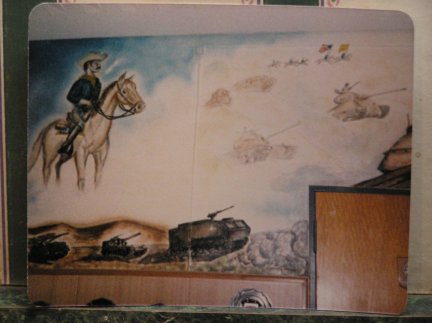 |
|
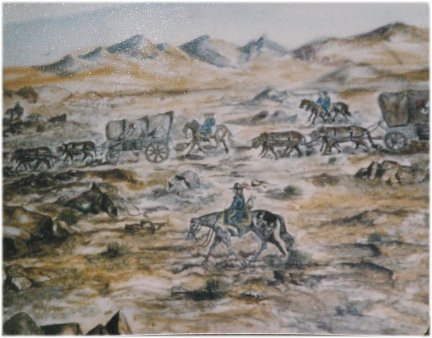 |
|
| |
As soldier art goes, these murals lasted about eighteen years, a
long run considering repainting projects were always popular in the
Spring.
- Deb Cawley |
|
Part of the western cavalry scene that graced most of the long wall
opposite the bank of windows in the conference room. Thanks very
much to Deb Cawley for having the presence of mind to take the
photos back in the mid 1980s and then dig them out of storage and
sending them along!
- Deb Cawley |
|
I had some artistic talent and asked it I could paint a
mural on the side of the wall that faced out towards the
main corridor that ran through the HQ building. I worked
in my off shift hours and little by little, began to
tell the story of the border complete with East German
towers , US tanks and APCs, Soviet equipment and
helicopters. Not sure that I really wanted it to be an
accurate painting of the border but more of an
impression of what the border really meant. I signed my
name in the corner and SSG Ric Badal took a foto and
wrote an article about the mural for the Blackhorse
newspaper. Later, while out - processing, I felt really
proud to have left something behind. New officers and
NCOs who were in - processing and junior enlisted men
who were getting security clearances would pass by the
mural on the way into the S2 shop and for many, this
would have been their first introduction to the border.
Details are fuzzy as to the fate of Delbert's mural, it
probably was painted over in the mid 1980s during the
same beige painting spree that claimed the murals in the
Squadron Conference Room.
The trooper art at Daley Barracks now lives only in our
memories and photographs, however, local German artists
have taken the opportunity to use the exterior walls of
the former EM Club as an outdoor space for large, public
art. The initial theme is the modern generation
considering the Nazi past. Newer art has also been added
to display the skills of young artists working in a
decidedly urban "tagging" theme.
As always, additional photos showing the American
trooper art are welcomed even if they only show a
portion of our missing murals.
Thanks to Erwin Ritter, Roland Ansorge / Sparkasse Bad
Kissingen, Saale Zeitung, Bill McCaskill, BG (Ret) Mike
O’Connell, Col (Ret) Paul Palmer, CSM (Ret) Ernest C.
Jeffries, MSG (Ret) Helmut Grossinger, Delbert
Richardson, Todd Stach, Richard Harrington and all the
others who helped tell this story.
(Jan 2008)
|
|